If you are looking for some unique, attractive, and interesting fish to keep in your guppy tank then you are in the right place.
In this article, I am going to show you the best tank mates for guppies.
The list of the best tank mates for guppies are as follows:
- Dwarf neon rainbowfish
- Sparkling Gourami
- Honey Gouramis
- Chili Rasbora
- Dwarf Chain Loach
- Rainbowfish (Boeseman’s)
- Siamese Algae Eater
- Ghost shrimp
- Indian glassfish
- Espei rasbora
- Nerite Snails
- White Cloud Mountain Minnow
- celestial pearl danios
- Ember tetras
- Swordtails
- Platies
- Black molly
- Cory Catfish
- Harlequin Rasboras
- Cardinal Tetra
- Otocinclus Catfish
- Kuhli Loach
- Red Cherry Shrimp
- African Dwarf Frog
- Zebra Danio
- Ram Cichlids
- Rummy Nose Tetra
- Bristlenose Pleco
- Female Betta
- Amano Shrimp
- Crystal Red Shrimp

Now I am going to you tell you what actually makes a good tank mate for your guppies.
And I am going to cover all the details that you need to know to get started with keeping any or multiple of the fish mentioned in the above list in your guppy tank.
Table of Contents
How to choose tank mates for guppies?
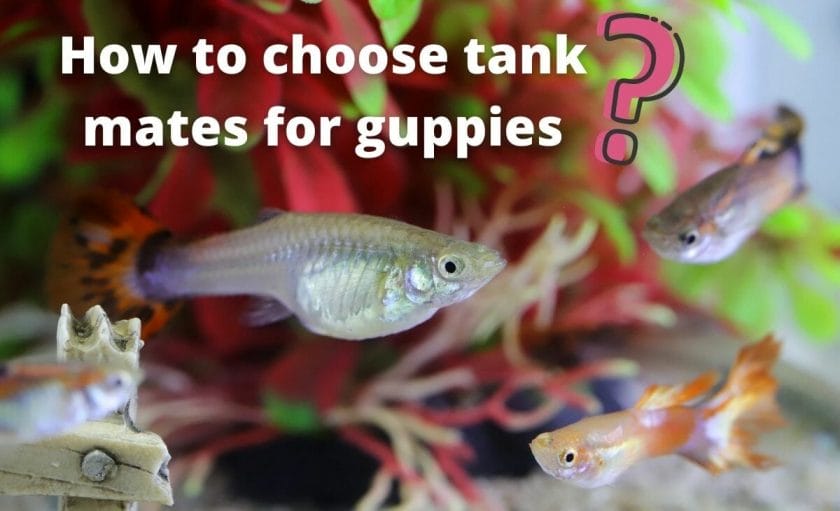
Choosing tank mates for your guppies is not rocket science but there are a few things that you need to keep in mind while choosing tank mates for your guppies.
1. The fish should require similar water conditions as guppies
When you want to keep other fish with your guppies you will need to make sure that the other fish requires similar water conditions i.e. water temperature, water pH, and water hardness as your guppies need.
This is important because every fish has specific water conditions requirements. And if you don’t provide them with the ideal water conditions then it’s not good for their health, proper growth, and development.
Here’s a table showing the ideal water parameters for guppies
| PARAMETERS | VALUES |
|---|---|
| FISH | Guppies |
| SCIENTIFIC NAME | Poecilia reticulata |
| CARE LEVEL | Easy |
| MAXIMUM SIZE | 2 inches |
| AVERAGE LIFESPAN | 2-4 years |
| DIET | Omnivore |
| WATER TEMPERATURE | 64–82° F |
| WATER pH | 5.5–8.0 |
| WATER HARDNESS | 10–30 |
| MINIMUM TANK CAPACITY | 5 gallons |
| BREEDING | Livebearers |
2. You should choose peaceful fish for your guppies
Guppies are small peaceful fish. Guppies don’t bother any other fish.
But other aggressive fish can attack guppies and this can stress guppies.
If guppies are stressed continuously then this can lead to diseases and it can even lead to the death of the fish.
That’s why while choosing tank mates for guppies make sure that the other fish have a peaceful temperament and is not known for aggressive behavior.
3. Choose smaller freshwater fish
Guppies are small freshwater fish. So while choosing tank mates for guppies make sure that the other fish is not too big that guppies can fit into their mouth.
Because if guppies can fish into any other fish’s mouth then they can intentionally or accidentally eat guppies.
4. Avoid keeping fin nipper fish with your guppies
One of the reasons we love puppies is because of their beautiful big fins.
These attractive guppy fins also attract other fin nipper fish.
Fin nipper fish can tear the fins of guppies which can lead to bacterial infection in guppies.
The bacterial infection can even cause the death of the guppies.
So while choosing tankmates for your guppies make sure that the other fish is known for nipping on other fish’s fins.
Best tank mates for guppies
1. Dwarf neon rainbow fish
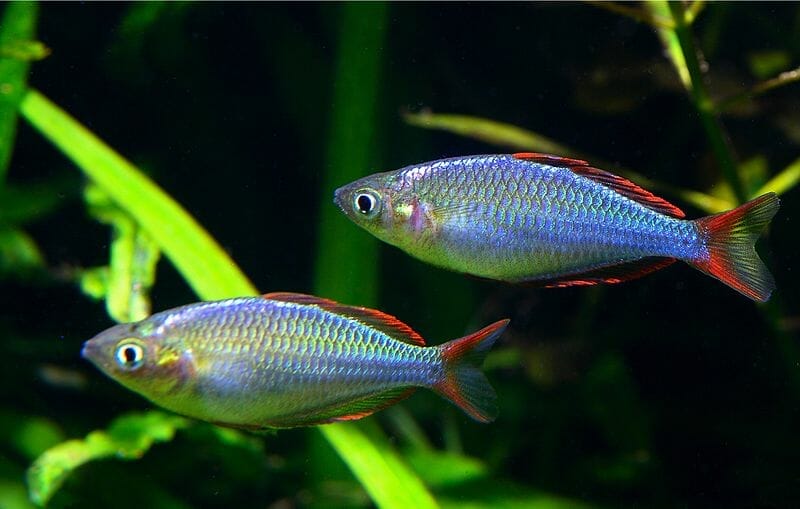
Image by Anandarajkumar at en.wikipedia under CC BY-SA 3.0
| PARAMETERS | VALUES |
| FISH | Dwarf neon rainbowfish |
| SCIENTIFIC NAME | Melanotaenia praecox |
| CARE LEVEL | Moderate |
| MAXIMUM SIZE | 5 cm (2.0 in) |
| AVERAGE LIFESPAN | 3 to 5 years |
| DIET | Omnivorous |
| WATER TEMPERATURE | 73° – 82° F (23° – 28° C), |
| WATER pH | 6.8 – 7.5 |
| WATER HARDNESS | 8 – 12 dKH |
| MINIMUM TANK CAPACITY | 20 gallons |
| BREEDING | Egg layer |
| TEMPERAMENT | Peaceful |
Dwarf neon rainbow fish is a very active schooling fish you can keep with your guppies.
These fish features vivid red and blue coloration.
Both males and females show great coloration. However, males display the brightest coloration.
As Dwarf neon rainbow fish is a schooling fish you should keep them in at least a group of 6 fish.
As you will need to keep them in a group you will need to keep them in a larger tank of at least 20 gallons or above.
Dwarf neon rainbow fish prefers as a heavily planted tank. So if you want to keep them with your guppies then you should also keep some live aquarium plants in your aquarium.
Why Dwarf neon rainbow fish is a good tank mate for guppies?
Dark neon rainbow fish requires similar water conditions as your guppies need.
Dwarf neon rainbow fish is a small freshwater fish that can grow a maximum of 2 inches so there is no possibility that the fish can eat your guppies.
They are also very peaceful fish and they will not harm your guppies.
Just like guppies, Dwarf neon rainbowfish are omnivorous so they will accept the food that you feed to your guppies.
2. Sparkling gourami
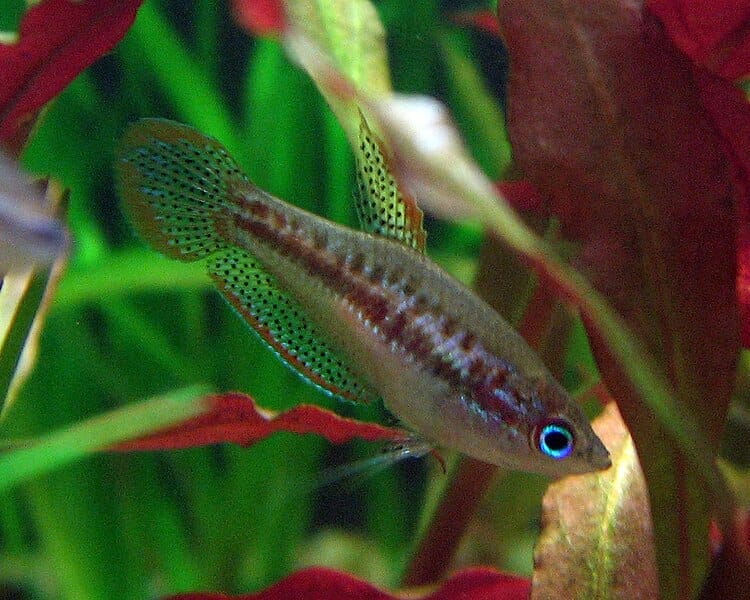
Image by Zikamoi under CC BY-SA 3.0
| PARAMETERS | VALUES |
| FISH | Sparkling Gourami |
| SCIENTIFIC NAME | Trichopsis pumila |
| CARE LEVEL | Easy |
| MAXIMUM SIZE | Up to 1.6 inches |
| AVERAGE LIFESPAN | 4-5 years |
| DIET | Omnivore |
| WATER TEMPERATURE | 76°F to 82°F |
| WATER pH | 6 to 7 |
| WATER HARDNESS | 4-8 KH |
| MINIMUM TANK CAPACITY | 15 gallons |
| BREEDING | Egglayer |
| TEMPERAMENT | Peaceful |
If you want to keep a unique attractive fish in your guppy fish tank then Sparkling gourami is for you.
This fish is not very popular in the aquarium hobby. You will not see them in a lot of home aquariums which makes them quite unique.
Do sparkling gourami are not schooling fish they do like to be in groups. So ideally, you should keep them in a group.
Sparkling gourami doesn’t grow too large. They grow a maximum of 1.6 inches. So even if you keep them in a group, you could keep them in a 15-gallon tank.
Adult Sparkling gourami has a labyrinth organ. So you will see some unique behavior when they breathe using the labyrinth organ.
When they breathe with the labyrinthorgan they will swim up to the surface of the water of your fish tank.
What makes sparkling gourami the best tank mate for guppies?
Sparkling gourami requires similar water conditions as your guppies need so they can both live in the same tank.
Sparkling gourami is a small freshwater fish that can grow a maximum of 1.6 inches so there is no way this fish can eat your guppies.
Also, Sparkling gourami is are very peaceful fish so they will not attack your guppies.
Sparkling gourami is omnivorous so they will accept the food that you feed to your guppies.
11 Easy Ways to Keep Your Guppies Happy and Healthy
3. Honey gourami
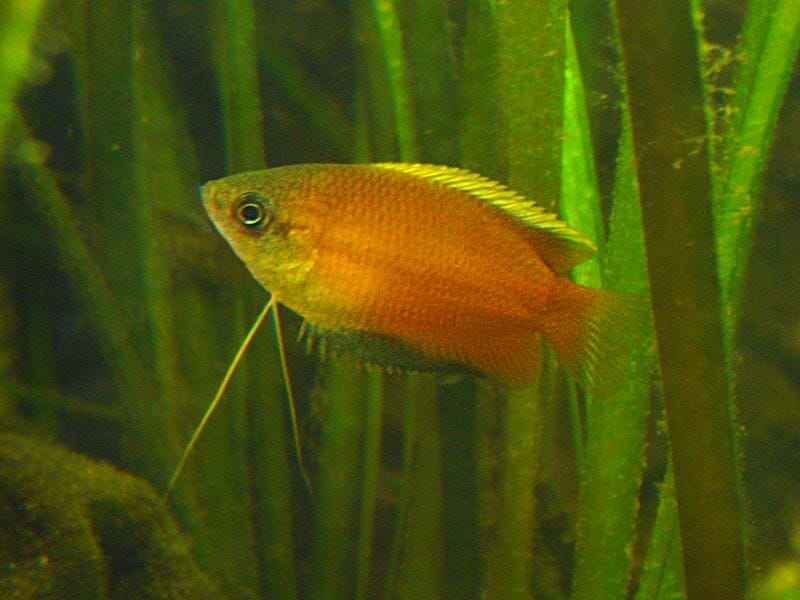
| PARAMETERS | VALUES |
| FISH | Honey Gouramis |
| SCIENTIFIC NAME | Trichogaster chuna |
| CARE LEVEL | Beginner |
| MAXIMUM SIZE | 3 inches |
| AVERAGE LIFESPAN | 4-8 years |
| DIET | Omnivore |
| WATER TEMPERATURE | 71-82°F |
| WATER pH | 6.0-7.5 |
| WATER HARDNESS | 4-15 dGH |
| MINIMUM TANK CAPACITY | 10 gallons |
| BREEDING | Egg-layer |
| TEMPERAMENT | Peaceful |
If you are a beginner in the hobby and looking for a hardy fish to keep with guppies then Honey gourami is a good choice for you.
Honey gourami is also known as Sunset honey gourami. Red flame gourami, Red honey gourami, etc.
There are similarities in the size and shape of Honey gourami and Dwarf gourami that’s why people generally get confused between them.
So while purchasing the Honey gourami you should look at their scientific name to differentiate the two.
Naturally, Honey gourami are found in lakes and rivers where there is a lot of vegetation.
And they do like to hide in the vegetation, behind plants so if you want to keep them in your guppy tank, ideally, you should also plant some live aquarium plants in your tank so they can hide behind the plants.
Why Honey gourami is the best tank mate for guppies?
Honey gourami requires similar water conditions as your guppies need so you can keep both of them in the same tank.
The hardiness and peaceful nature of Honey gourami make a very good choice to keep them with guppies, especially, if you are a beginner.
Honey gourami is a very small fish so there is no way that they can eat your guppies.
Honey gourami is not a schooling fish so you don’t need to keep them in a group. You can keep only single Honey gourami in a 10-gallon guppy tank.
How Can I Enhance My Guppy Color? (11 Easy Tips)
4. Chili rasbora
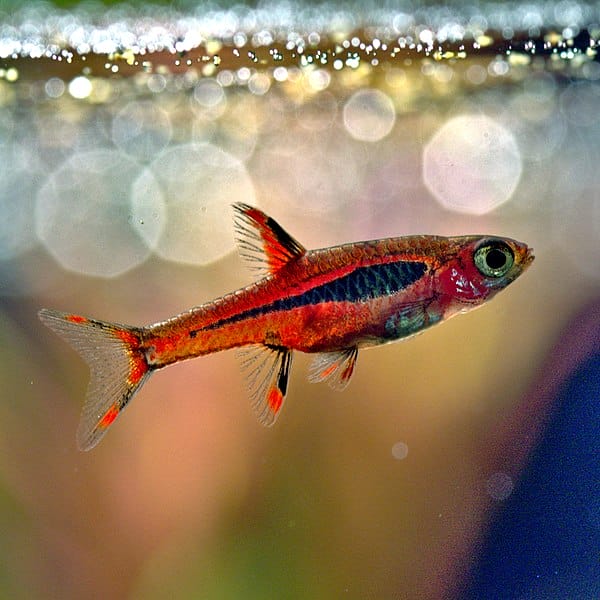
Image by JoKrimmel under the Creative Commons Attribution-Share Alike 4.0 International license.
| PARAMETERS | VALUES |
| FISH | Chili Rasbora |
| SCIENTIFIC NAME | Boraras brigittae |
| CARE LEVEL | Easy |
| MAXIMUM SIZE | .6-.8 inch |
| AVERAGE LIFESPAN | 6-8 years |
| DIET | Omnivore/Micropredator |
| WATER TEMPERATURE | 68-82.4° F (20°-28° C) |
| WATER pH | 4.0-7.0 |
| WATER HARDNESS | 1-2 |
| MINIMUM TANK CAPACITY | 5 gallons |
| BREEDING | Egg-layer |
| TEMPERAMENT | Peaceful |
Chili rasbora is one of the smallest freshwater aquarium fish.
Chili rasbora is also known as mosquito rasboras.
This fish can grow a maximum of 0.8 inches.
Males are smaller in size than females but males feature beautiful ruby red colour and are more attractive than females.
Chili rasboras are also schooling fish so ideally, you should keep them in a group.
Generally, Chili rasbora doesn’t jump out of the tank. However, if the water conditions in the tank are not favorable or ideal for them then they may try to leap out of the tank.
So you should keep a lid on your aquarium if you want to keep this fish in your tank.
What makes Chili rasbora the best tank mate for your guppies?
Chili rasbora is a very peaceful fish so they will not bother your guppies.
They require similar water conditions as your guppies need so you can easily keep them both together in the same tank.
Chili rasbora is particularly a good choice for you if you have a nano tank because they are so small that you can easily keep them in a 5-gallon tank with your guppies.
Also, Chili rasbora is an omnivorous fish so it will happily eat the food that you feed to your guppies.
How Do I Stop My Guppies From Having Babies? (5 Effective Ways That Work!)
5. Dwarf chain loach
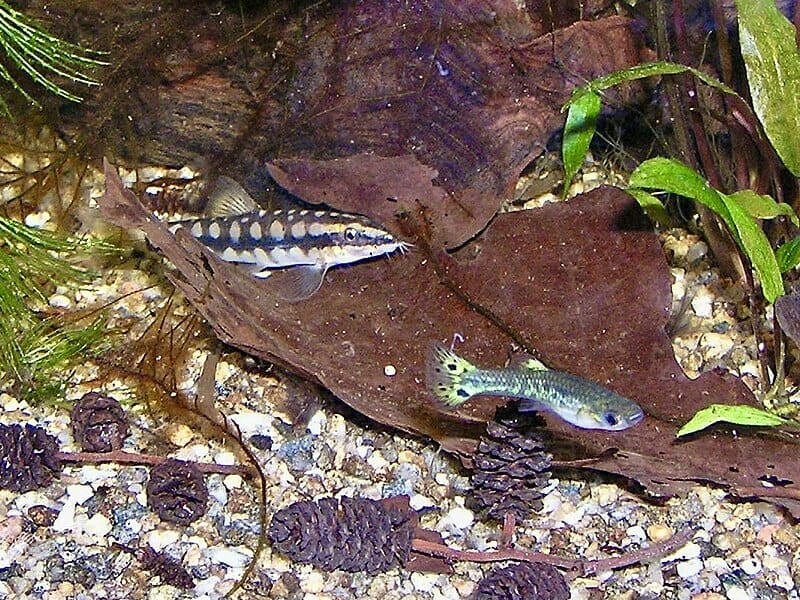
Image by NasserHalaweh under the Creative Commons Attribution-Share Alike 4.0 International license.
| PARAMETERS | VALUES |
| FISH | Dwarf Chain Loach |
| SCIENTIFIC NAME | Ambastaia sidthimunki |
| CARE LEVEL | Moderate |
| MAXIMUM SIZE | 2 inches |
| AVERAGE LIFESPAN | 8 and 12 years |
| DIET | Omnivore |
| WATER TEMPERATURE | 72-86° F |
| WATER pH | 6.0-7.5 |
| WATER KH | 8-12 |
| MINIMUM TANK CAPACITY | 20 gallons |
| BREEDING | Egg layer |
| TEMPERAMENT | Semi-aggressive |
If you want to keep an active bottom-dweller fish in your guppy tank then Dwarf chain loach is a good choice for you.
These fish are also known as scaleless fish. However, they do have scales embedded in their skin.
Dwarf chain loach like to be in groups so you should keep them in a group with your guppies.
Dwarf chain loach likes a lot of places to hide. So if you want to keep them in your tank you should provide them with a lot of hiding places like caves, decorations, etc.
Dwarf chain loach is also known to be semi-aggressive. So they may attack your guppies so you should only keep them if you have a large planted tank where there are a lot of hiding places for your guppies to hide from them.
Why Dwarf chain loach could be a good tank mate for your guppies?
You can keep Dwarf chain loach with your guppies because both fish require similar water conditions.
And Dwarf chain loach is omnivorous so it will happily accept the leftover food that sinks to the bottom of the fish tank that you feed to your guppies.
But as I mentioned above, Dwarf chain loach is semi-aggressive so they may attack your guppies. However, Dwarf chain loach are bottom-dwelling fish. And generally, guppies don’t wander near the bottom of a fish tank so they are safe from Dwarf chain loach.
But it is a good idea to have a lot of hiding places and live plants in your tank so that your guppies can hide from the Dwarf chain loach if they are being attacked.
Breeding Guppies? 11 Things You Must Know to Be a Successful Breeder
6. Boeseman’s Rainbowfish
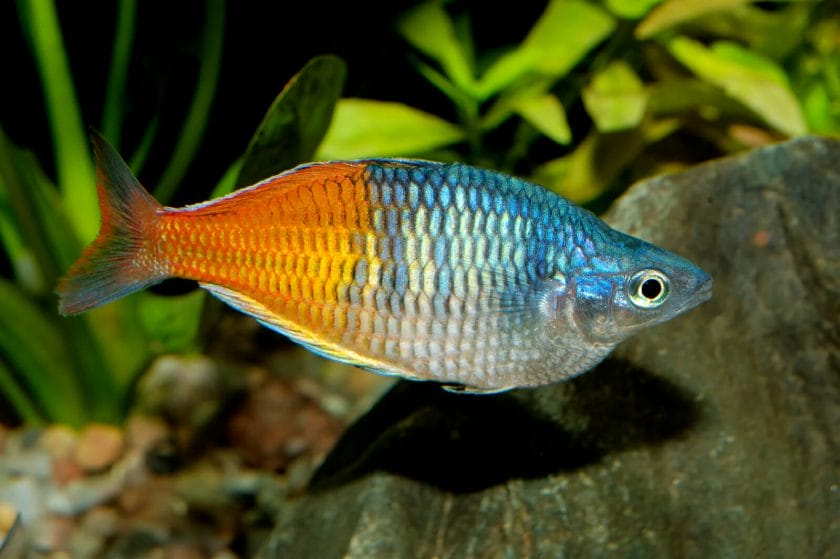
| PARAMETERS | VALUES |
| FISH | Boeseman’s rainbowfish |
| SCIENTIFIC NAME | Melanotaenia boesemani |
| CARE LEVEL | Easy |
| MAXIMUM SIZE | Up to 4.5 inches |
| AVERAGE LIFESPAN | 5-8 years |
| DIET | Omnivore |
| WATER TEMPERATURE | 81-86°F (27-30°C) |
| WATER pH | 7.0-8.0 |
| WATER GH | 10-20°H |
| MINIMUM TANK CAPACITY | 30 gallons |
| BREEDING | Egg layer |
| TEMPERAMENT | Peaceful |
If you are looking for a colorful fish to keep in your guppy fish tank then Boeseman’s Rainbowfish is for you.
Boeseman’s Rainbowfish is a very popular fish in the aquarium hobby and you can find them in most of the aquarium stores.
These fish are very peaceful so you can easily give them with your guppies.
This fish features bright colors. Males are more colorful and attractive than females.
The way to differentiate males and females is by their colors. As I mentioned earlier. males are more colorful and have bright colors. Also, males can grow as large as 4.5 inches long whereas females don’t grow more than 3 inches.
Boeseman’s Rainbowfish is a shoaling fish so ideally, we should keep them in a group.
Boeseman’s Rainbowfish do like planted aquariums. However, they also like to have open space to swim so don’t keep them in a very heavily planted tank.
Why Boeseman’s Rainbowfish is the best tank mate for guppies?
Boeseman’s Rainbowfish is a very peaceful fish so it will not bother your guppies and they can live happily together in the tank.
Boeseman’s Rainbowfish require similar water conditions as guppies need so you can easily keep them both together in the same tank.
This fish does grow a bit larger (it can grow up to 4.5 inches) but it doesn’t grow so large that the guppies can fit into their mouth so there is no possibility that Boeseman’s Rainbowfish will eat your guppies.
Besides, these fish are omnivorous so they can eat the food you feed to your guppies.
7. Siamese Algae Eater
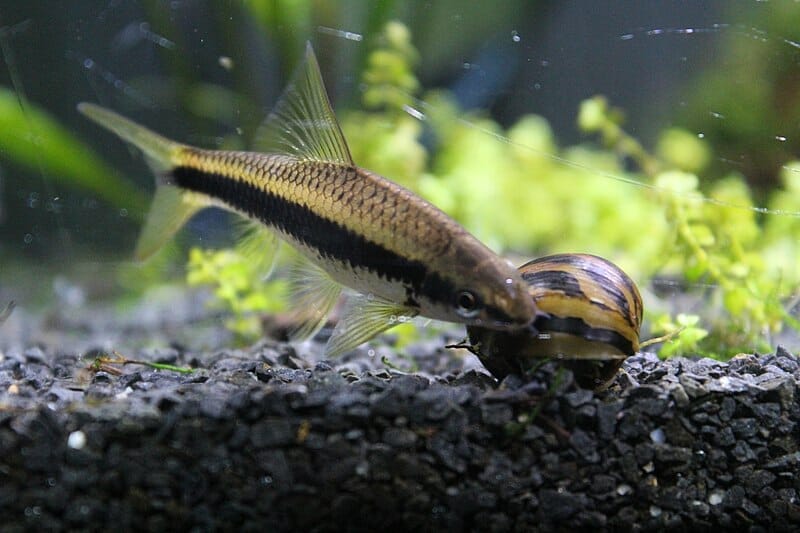
Image by aleander2137 the Creative Commons Attribution-Share Alike 4.0 International license.
| PARAMETERS | VALUES |
| FISH | Siamese Algae Eater |
| SCIENTIFIC NAME | Crossocheilus oblongus |
| CARE LEVEL | Easy |
| MAXIMUM SIZE | 6 inches |
| AVERAGE LIFESPAN | Up to 10 years |
| DIET | Omnivore |
| WATER TEMPERATURE | 72° – 79° F (22° – 26° C) |
| WATER pH | 6.5 – 7.5 |
| WATER KH | 4 – 15 dKH |
| MINIMUM TANK CAPACITY | 20 gallons |
| TEMPERAMENT | Peaceful |
Siamese algae eater fish is, as the name suggests, an algae eater fish. In fact, Siamese algae eater fish is a one of the very few fish that eat beard algae.
Beard algae is very difficult to remove by hand so this fish will take care of it in your tank.
So it will eat the algae in your fish tank and will help you to keep your fish tank clean.
This fish is very active and you can keep them in groups or you can even keep single Siamese Algae Eater fish in your tank.
This fish is not a fussy eater so it will happily eat whatever you put in the fish tank.
Naturally, they are found in very densely planted rivers and streams so ideally, you should keep them in a very heavily planted tank.
Why Siamese Algae Eater fish is the best tank mate for guppies?
Siamese Algae Eater fish requires similar water conditions as your guppies need so they can both live together in the same tank.
Siamese Algae Eater can grow pretty large. It can grow up to 6 inches but it is a very peaceful fish so it will not bother your guppies.
Just like your guppies Siamese are also very easy to care for so if you are a beginner this is an ideal tank mate to keep with your guppies.
8. Ghost shrimp
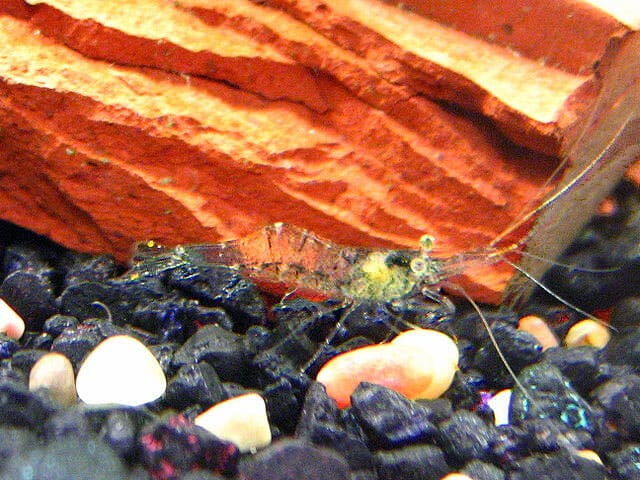
| PARAMETERS | VALUES |
| FISH | Ghost shrimp |
| SCIENTIFIC NAME | Palaemonetes paludosus |
| CARE LEVEL | Easy |
| MAXIMUM SIZE | 1.5 inches |
| AVERAGE LIFESPAN | 1 year |
| DIET | Omnivore |
| WATER TEMPERATURE | 72 – 82 degrees Fahrenheit |
| WATER pH | 7-8 |
| WATER KH | 5-8 ppm |
| MINIMUM TANK CAPACITY | 5-10 gallons |
| TEMPERAMENT | Peaceful |
| BREEDING | Egg layer |
| WATER GH | 5 – 8 |
If you are looking for a cleaner shrimp to keep your aquarium clean and tidy then Ghost shrimp is for you.
Ghost shrimp will eat the uneaten food in your aquarium. And it will also eat algae in your tank and help you to keep your aquarium clean.
Ghost shrimp don’t grow too large. It can grow a maximum of 1.5 inches so you can easily keep them in a group in your aquarium.
However, if you keep a single Ghost shrimp, it will live happily in the tank.
One thing to keep in mind while buying Ghost shrimp is that you should make sure that the Ghost shrimp are bred for home aquariums and are not bred as feeder shrimp. This is important because generally feeder shrimps are not taken good care of so they will not live for a long time in your aquarium.
Besides, as Ghost shrimp grow bigger they will molt.
Here is an interesting video showing how Ghost shrimp molt.
Why ghost shrimp is the best tank mate for your guppies?
Ghost shrimp require similar water conditions as your guppies need so you can easily keep them together in the same tank.
Ghost shrimps are very tiny. They can grow a maximum of 1.5 inches so you can easily keep them in your guppy tank especially if you have a smaller tank of 5 gallons.
Ghost shrimps are omnivorous so they will happily eat the food that you feed to you are guppies. And they will also eat algae in your tank and will help you to keep your aquarium algae free.
9. Indian glassfish
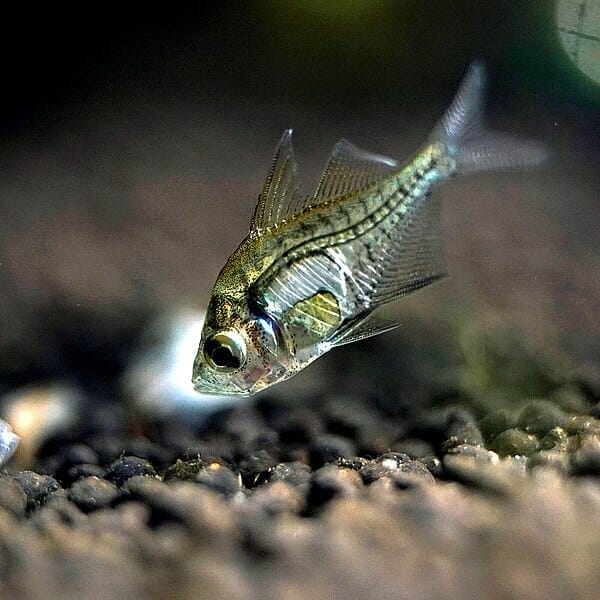
Image by opencage the Creative Commons Attribution-Share Alike 2.5 Generic license.
| PARAMETERS | VALUES |
| FISH | Indian glassfish |
| SCIENTIFIC NAME | Parambassis ranga |
| CARE LEVEL | Moderate |
| MAXIMUM SIZE | 3.1 in |
| AVERAGE LIFESPAN | 3-4 years |
| DIET | Carnivorous |
| WATER TEMPERATURE | 68-86°F (20-30°C) |
| WATER pH | 6.5-8.0 |
| MINIMUM TANK CAPACITY | 10 gallon |
| TEMPERAMENT | Peaceful |
| BREEDING | Egg layer |
| WATER GH | 8-20°H |
If you are looking for a unique fish to keep in your guppy tank then Indian glassfish is for you.
Indian glassfish is also known as Indian x-ray fish and Indian glassy fish.
Indian glassfish have a transparent body and you can literally see their bones and internal organs from outside.
Indian glassfish will eat small live and frozen foods. However, they don’t like to eat dried foods such as flakes.
Painted Indian Glassfish
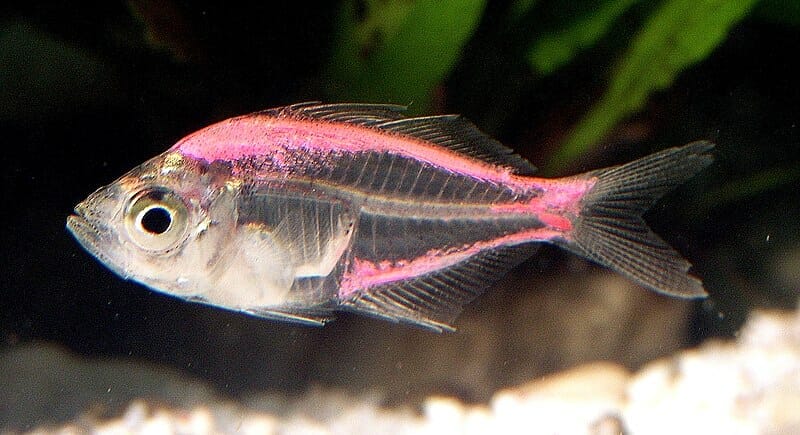
Indian glassfish are commonly sold as painted fish or disco fish.
Painted fish basically means that color is injected into the fish’s body to make them colorful.
This process is very painful for the fish. And it makes them susceptible to diseases.
So you should avoid getting a painted Indian glassfish.
Indian glassfish is coronavirus so you should avoid feeding them foods that contain plant-based ingredients.
Why Indian glassfish is the best tank mate for your guppies?
Indian glassfish require similar water conditions as your guppies need so you can easily keep them in the same tank.
Indian glassfish are also small fish that can grow a maximum of 3.1 inches. Also, they are very peaceful fish so they will not bother your guppies.
Indian glassfish is not a schooling fish so you can keep a single fish in your guppy tank. So if you have a small tank of up to 10 gallons then you can easily keep an Indian glassfish with your guppies.
10. Espei rasbora
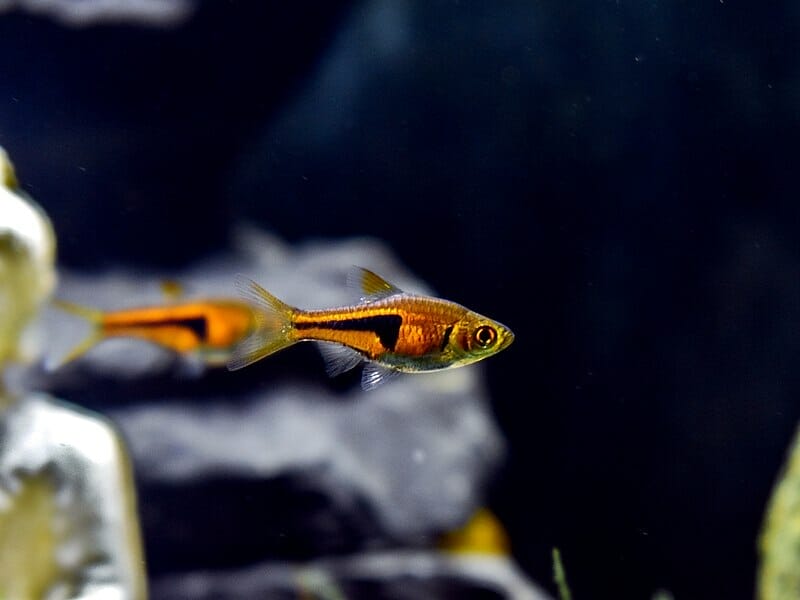
Image by Atulbhats under the Creative Commons Attribution-Share Alike 4.0 International license.
| PARAMETERS | VALUES |
| FISH | Espei rasbora |
| SCIENTIFIC NAME | Trigonostigma espei |
| CARE LEVEL | Easy |
| MAXIMUM SIZE | 1 – 1.5 inches (2.5 – 3.8 cm) |
| AVERAGE LIFESPAN | 3 to 5 years |
| DIET | Omnivorous |
| WATER TEMPERATURE | 72° – 79° F (22° – 26° C) |
| WATER pH | 6.0 – 7.0 |
| MINIMUM TANK CAPACITY | 10 gallons |
| TEMPERAMENT | Peaceful |
| BREEDING | Egg layer |
| WATER KH | 2 – 10 dKH |
Espei rasbora is also known as Lambchop rasbora because the black marking on the side of the body of this fish resembles lambchop.
This fish is a schooling fish so you should keep them in at least a group of 6.
They are very tiny fish that can grow a maximum of 1.5 inches so you can easily keep them in a group even in a 10-gallon tank.
Also, these fish are not very fussy eaters and they will eat anything that you put in their tank as far as the food fits into their tiny mouth.
People have found that Espei rasbora shows the best coloration if you feed them frozen and live foods such as Brine shrimp, daphnia, bloodworms, etc.
Just like guppies, you can also feed them vegetables like zucchini, lettuce, kale, etc.
My Espei rasbora is the best bank mate for guppies?
Espei rasbora is a small peaceful fish so it will not bother your guppies.
This fish is especially a good choice for you if you have a small tank of up to 10 gallons because these fish are small. And even if you keep them in a group you can easily keep them in a 10-gallon tank.
Besides, the water parameters that Espei rasbora requires are similar to what your guppies need so they can both live together in the same tank.
Also, Espei rasboras are omnivorous so just like guppies, they will eat the food you feed to your guppies.
11. Nerite snail
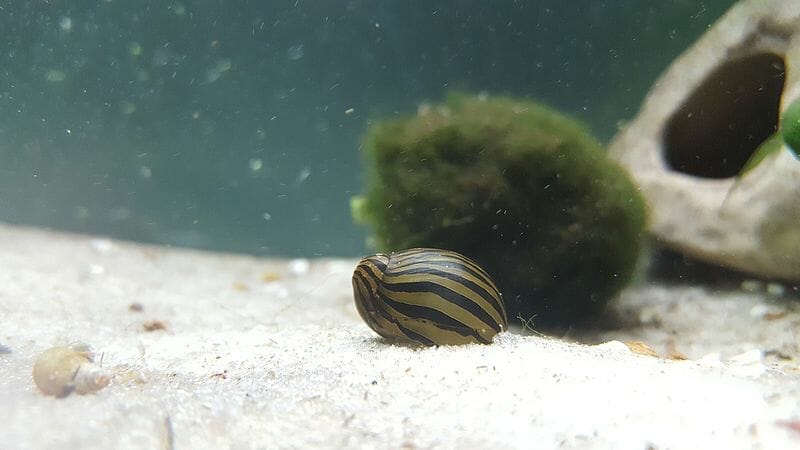
Image by Evan Baldonado under the Creative Commons Attribution-Share Alike 4.0 International license.
| PARAMETERS | VALUES |
| FISH | Nerite Snails |
| SCIENTIFIC NAME | Nerita |
| CARE LEVEL | Easy |
| MAXIMUM SIZE | 1 inch |
| AVERAGE LIFESPAN | 1 year |
| DIET | Herbivorous |
| WATER TEMPERATURE | 72 – 78 degrees Fahrenheit |
| WATER pH | around 7.5 |
| MINIMUM TANK CAPACITY | 5 gallon |
| TEMPERAMENT | Peaceful |
| BREEDING | Egg layer |
| WATER GH | 12-18 |
| WATER KH | 12-18 |
If you are looking for an algae eater to keep in your tank that is super hardy and easy to take care of then Nerite snails are a choice for you.
Nerite snails are very good at eating algae from the aquarium glass walls and decorations so they will help you to keep your aquarium algae free.
Besides, there are a lot of different types of Nerite snails to choose from. For example.., Tiger nerite snail, Black racer nerite snail, Zebra nerite snail, etc.
While choosing the Nerite snail for your aquarium make sure to choose an active nerite snail.
An active Nerite snail is usually stuck to a glass wall actively moving and eating algae.
Avoid choosing motionless Nerite snail or the snails that are fallen on the gravel or substrate upside down.
If you want to keep nerite snails in your tank then make sure to avoid any copper medications because copper medications can be fatal to Nerite snail snails.
When you keep Nerite snails in your tank, make sure to also supplement them with calcium supplements for their healthy shell.
Why Nerite snail is the best tank mate for your guppies?
Nerite snails can tolerate a wide range of water parameters so you can easily keep them in your guppies tank.
They are also very peaceful and prolific algae eaters so they will not bother you are guppies. And they will help you to keep your aquarium algae-free.
Also as nerite snail feed on algae in your aquarium, you don’t need to feed them separately.
Here’s a video showing Nerite snails eating algae in a fish tank.
Common guppies tank mates
The tank mates I’ve mentioned above are quite unique and you’ll not see a lot of guppy tanks with these tank mates.
Now I’m going to show you some common tank mates for your guppies.
12. White Cloud Mountain Minnow
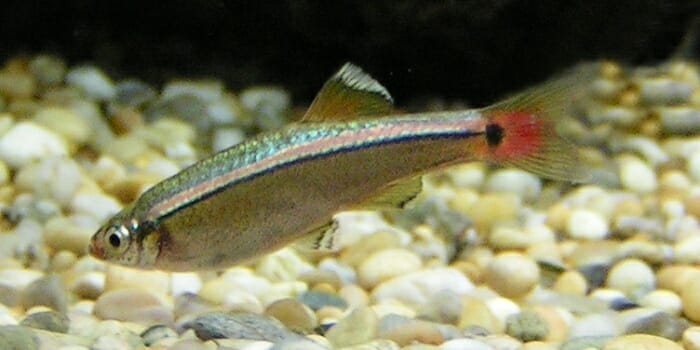
Image source under CC BY-SA 3.0
See more images at Amazon here
| PARAMETERS | VALUES |
|---|---|
| FISH | White cloud mountain minnow |
| SCIENTIFIC NAME | Tanichthys micagemmae |
| CARE LEVEL | Easy |
| MAXIMUM SIZE | 1 1/2 inches |
| AVERAGE LIFESPAN | 3 to 5 years |
| DIET | Omnivore |
| WATER TEMPERATURE | 60 F (15 1/2 C) |
| WATER pH | 6.0–8.0 |
| WATER HARDNESS | 5–19 dGH |
| BREEDING | Egg scatterers |
| MINIMUM TANK CAPACITY | 10 gallons |
13. Celestial pearl danios
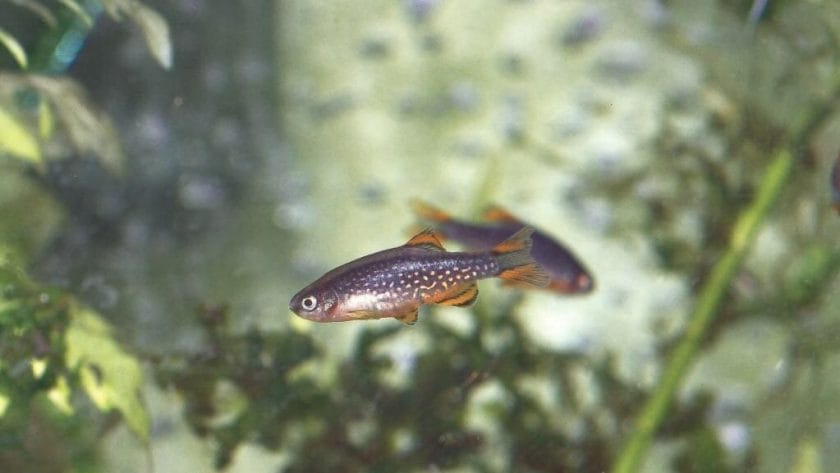
image by CheepShot under CC BY 2.0
| PARAMETERS | VALUES |
|---|---|
| FISH | Celestial pearl danios |
| SCIENTIFIC NAME | Danio margaritatus |
| CARE LEVEL | Medium |
| MAXIMUM SIZE | 1 inch |
| AVERAGE LIFESPAN | 3-4 years |
| DIET | Omnivorous |
| WATER TEMPERATURE | 73-79 |
| WATER pH | 6.5-7.5 |
| WATER HARDNESS | soft to medium |
| BREEDING | Egg layers |
14. Ember tetras
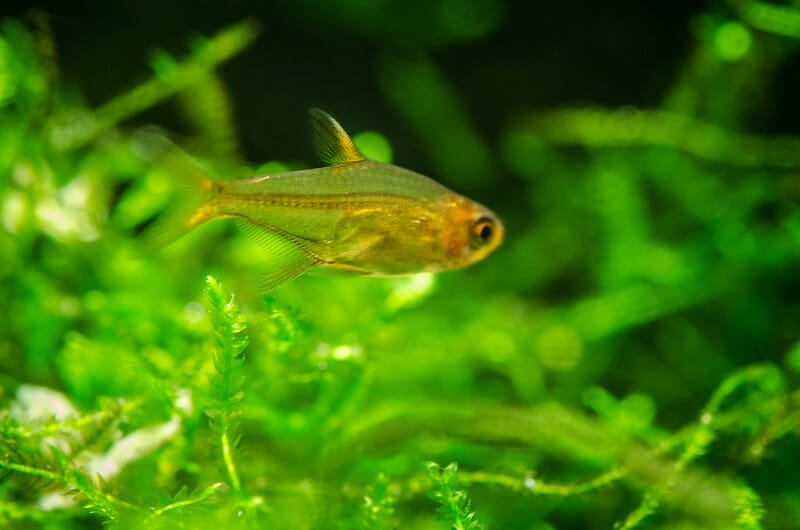
image by Dawn Endico under CC BY-SA 2.0
| PARAMETERS | VALUES |
|---|---|
| FISH | Ember Tetra |
| SCIENTIFIC NAME | Hyphessobrycon amandae |
| CARE LEVEL | Easy |
| MAXIMUM SIZE | 0.6–0.8 inch |
| AVERAGE LIFESPAN | Up to 2 years |
| DIET | Omnivore |
| WATER TEMPERATURE | 73–84°F |
| WATER pH | 6.5-7.5 |
| WATER HARDNESS | <18 dH |
| BREEDING | Egg layers |
15. Swordtails
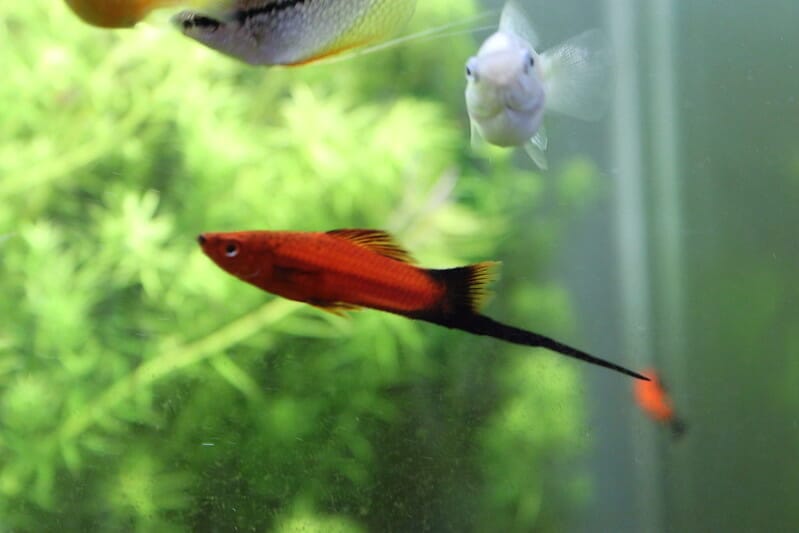
Image by Bernat Arlandis under CC BY-SA 2.0
| PARAMETERS | VALUES |
|---|---|
| FISH | Swordtail |
| SCIENTIFIC NAME | Xiphophorus helleri |
| CARE LEVEL | Easy |
| MAXIMUM SIZE | 5 inches |
| AVERAGE LIFESPAN | 3 - 5 years |
| DIET | Omnivores |
| WATER TEMPERATURE | 72°F - 82° F |
| WATER pH | 7 - 8 |
| WATER HARDNESS | 9° to 15° dH |
| MINIMUM TANK CAPACITY | 10 gallon |
| BREEDING | Livebearer |
16. Platies
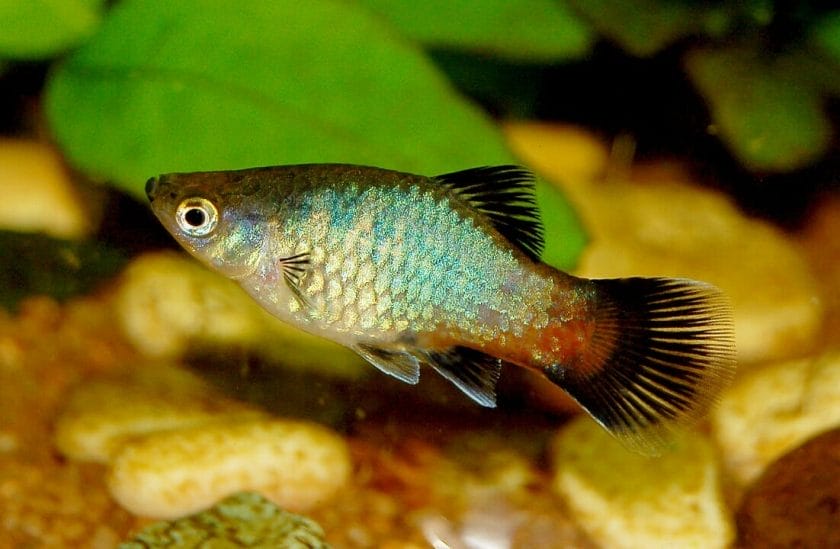
Image by Marrabbio2 under CC BY-SA 3.0
| PARAMETERS | VALUES |
|---|---|
| FISH | Platy |
| SCIENTIFIC NAME | Xiphophorus maculatus |
| CARE LEVEL | Easy |
| MAXIMUM SIZE | 2 inches |
| AVERAGE LIFESPAN | 2 - 3 years |
| DIET | Omnivores |
| WATER TEMPERATURE | 65°F - 77° F |
| WATER pH | 7 - 8 |
| WATER HARDNESS | 10° to 25° dH |
| MINIMUM TANK CAPACITY | 10 gallon |
| BREEDING | Livebearer |
17. Black molly
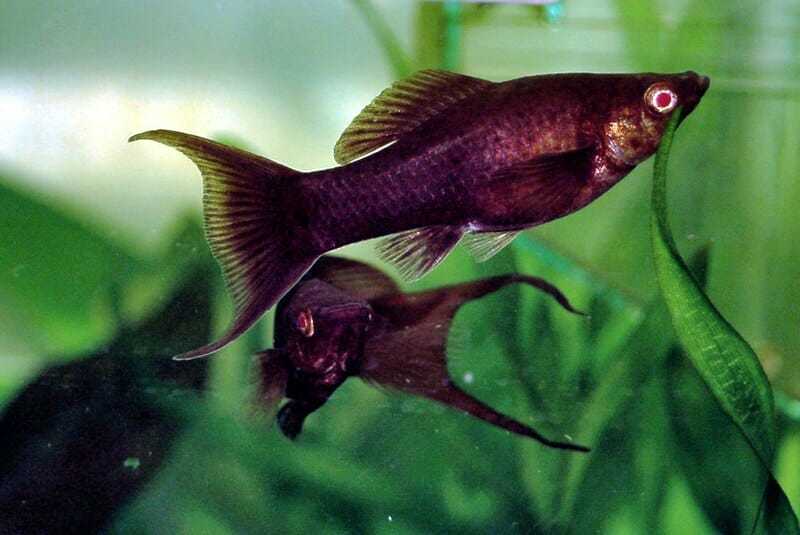
Black Molly by Marrabbio under CC BY-SA 3.0
| PARAMETERS | VALUES |
|---|---|
| FISH | Black Molly |
| SCIENTIFIC NAME | Poecilia sphenops |
| CARE LEVEL | Easy |
| MAXIMUM SIZE | 4 inches |
| AVERAGE LIFESPAN | 3 - 5 years |
| DIET | Omnivore |
| WATER TEMPERATURE | 70°F - 82°F |
| WATER pH | 7.5 - 8.5 |
| WATER HARDNESS | 10° to 25° dH |
| BREEDING | Live-bearers |
18. Cory Catfish
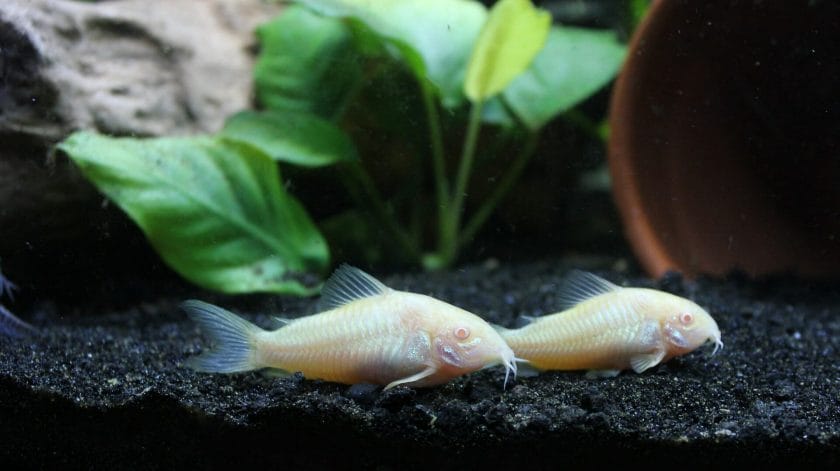
See more images at Amazon here
| PARAMETERS | VALUES |
|---|---|
| FISH | Corydoras |
| CARE LEVEL | Easy |
| MAXIMUM SIZE | 0.75-4 Inches |
| AVERAGE LIFESPAN | 5 Years |
| DIET | Omnivorous |
| WATER TEMPERATURE | 72 – 78°F |
| WATER pH | 7.0 – 7.8 |
| WATER HARDNESS | 5-10 dH |
| BREEDING | Egg layers |
19. Harlequin Rasboras

Image by Stefan Maurer under CC BY-SA 2.0
| PARAMETERS | VALUES |
|---|---|
| FISH | Harlequin Rasbora |
| SCIENTIFIC NAME | Trigonostigma heteromorpha |
| CARE LEVEL | Easy |
| MAXIMUM SIZE | 2 inches |
| AVERAGE LIFESPAN | 3 - 5 years |
| DIET | Omnivore |
| WATER TEMPERATURE | 72°F - 80° F |
| WATER pH | 5.5 - 7.0 |
| WATER HARDNESS | Up to 12° dH |
| BREEDING | Egg layer |
20. Cardinal Tetra
See more images at Amazon here
| PARAMETERS | VALUES |
|---|---|
| FISH | Cardinal Tetra |
| SCIENTIFIC NAME | Paracheirodon axelrodi |
| CARE LEVEL | Intermediate |
| MAXIMUM SIZE | Up to 2 inches |
| AVERAGE LIFESPAN | 2 - 5 years |
| DIET | Omnivore |
| WATER TEMPERATURE | 73°F - 80°F |
| WATER pH | 5.5 - 7 |
| WATER HARDNESS | 2° to 6° dH |
| BREEDING | Egg layer |
21. Otocinclus Catfish
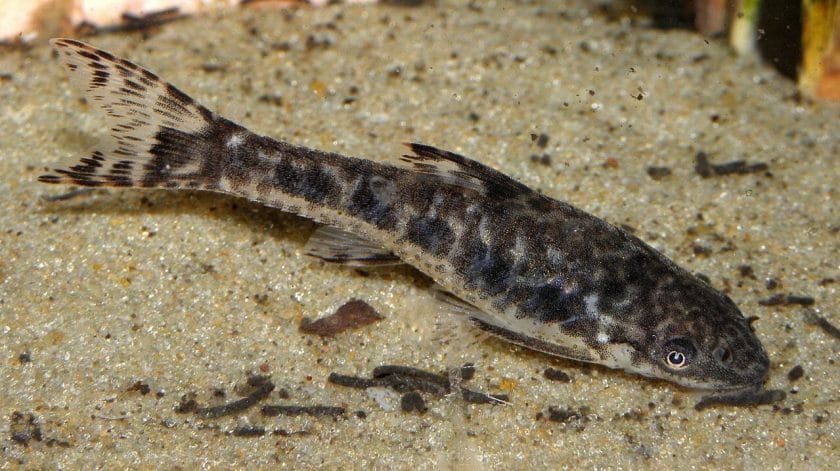
Image source under CC BY-SA 3.0
| PARAMETERS | VALUES |
|---|---|
| FISH | Otocinclus |
| SCIENTIFIC NAME | Otocinclus sp. |
| CARE LEVEL | Easy |
| MAXIMUM SIZE | 1-2 inches |
| AVERAGE LIFESPAN | 3-5 years |
| DIET | Herbivore |
| WATER TEMPERATURE | 74-80 Degree F. |
| WATER pH | 6-7.5 |
| WATER HARDNESS | 6° to 15° dH |
| BREEDING | Egg layers |
22. Kuhli Loach
See more images at Amazon here
| PARAMETERS | VALUES |
|---|---|
| FISH | Kuhli Loach |
| SCIENTIFIC NAME | Pangio kuhlii |
| CARE LEVEL | Intermediate |
| MAXIMUM SIZE | 4 inches |
| AVERAGE LIFESPAN | 10 years |
| DIET | Omnivore |
| WATER TEMPERATURE | 75° –86° F |
| WATER pH | 6.0–6.5 |
| WATER HARDNESS | up to 10° dH |
| MINIMUM TANK CAPACITY | 20 gallons |
| BREEDING | Egg Layer |
23. Red Cherry Shrimp
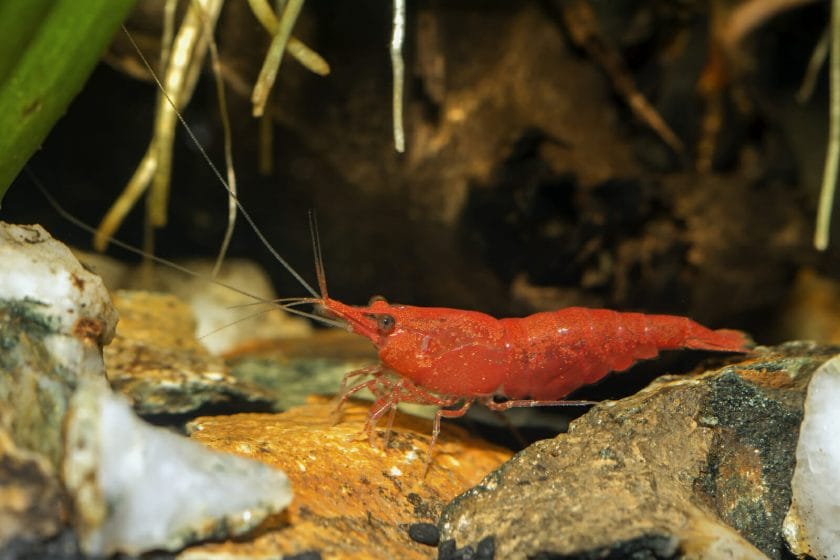
| PARAMETERS | VALUES |
|---|---|
| FISH | Cherry shrimp |
| SCIENTIFIC NAME | Palaemonetes sp. |
| CARE LEVEL | Easy |
| MAXIMUM SIZE | 1 - 2 inches |
| AVERAGE LIFESPAN | 1 - 2 years |
| DIET | Omnivorous |
| WATER TEMPERATURE | 65°F - 80°F |
| WATER pH | 6.5 - 8 |
| WATER HARDNESS | NA |
| BREEDING | Egg layers |
24. African Dwarf Frog
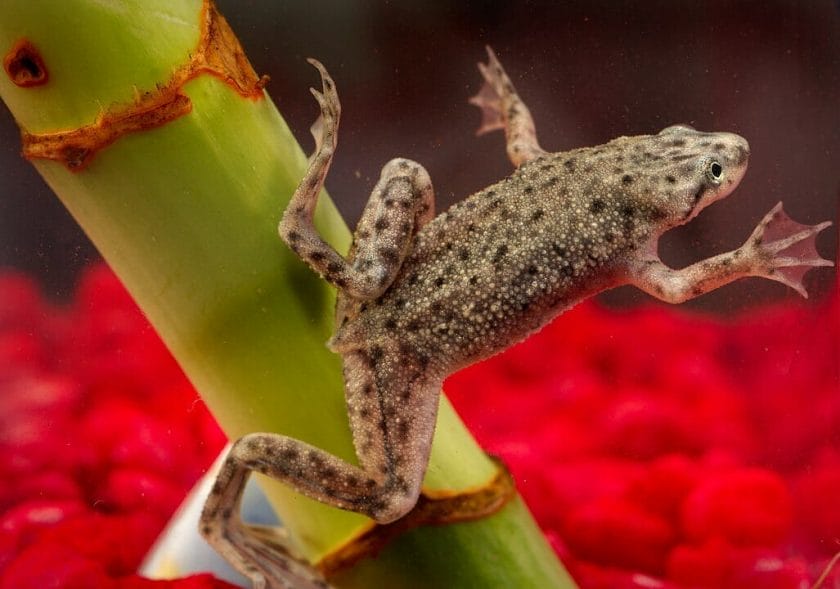
| PARAMETERS | VALUES |
|---|---|
| FROG | African dwarf frog |
| CARE LEVEL | Intermediate |
| MAXIMUM SIZE | 3 Inches |
| AVERAGE LIFESPAN | 5 Years |
| DIET | Omnivore |
| WATER TEMPERATURE | 72-78°F |
| WATER pH | 4-15 |
| WATER HARDNESS | 6.5-7.8 |
| BREEDING | Egg layers |
25. Zebra Danio
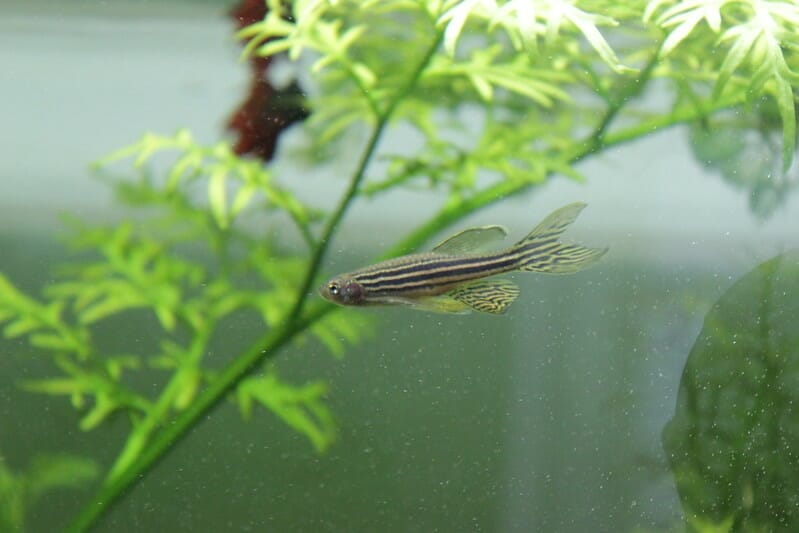
Image by Bernat Arlandis under CC BY-SA 2.0
| PARAMETERS | VALUES |
|---|---|
| FISH | Zebra Danios |
| SCIENTIFIC NAME | Danio rerio |
| CARE LEVEL | Easy |
| MAXIMUM SIZE | 2 inches |
| AVERAGE LIFESPAN | 5 years |
| DIET | Omnivore |
| WATER TEMPERATURE | 64° - 74° F |
| WATER pH | 6.5 to 7.0 |
| WATER HARDNESS | 5° to 12° dH |
| MINIMUM TANK CAPACITY | 10 gallon |
| BREEDING | Egg layer |
26. Ram Cichlids
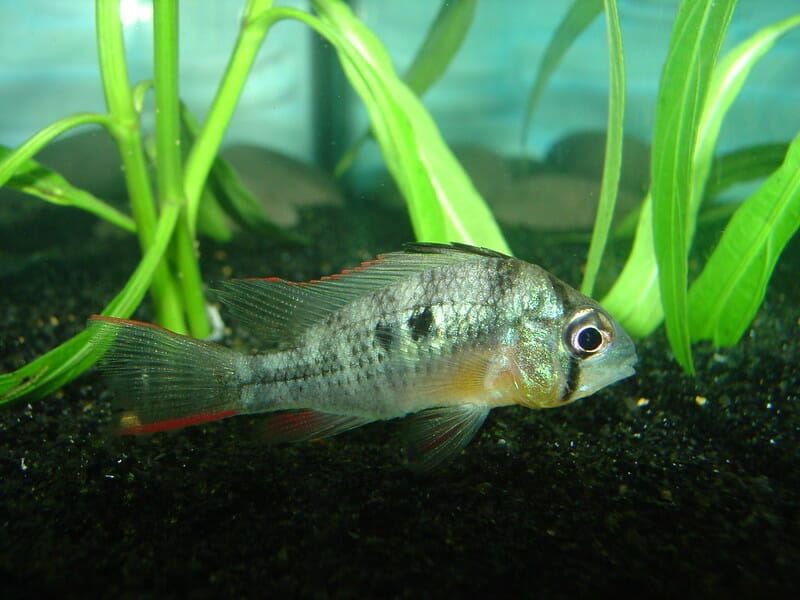
Image by NonstickRon under CC BY-SA 2.0
| PARAMETERS | VALUES |
|---|---|
| FISH | Bolivian Ram Cichlids |
| SCIENTIFIC NAME | Mikrogeophagus altispinosus |
| CARE LEVEL | Easy |
| MAXIMUM SIZE | 3.1 inches |
| AVERAGE LIFESPAN | 6 years |
| DIET | Omnivorous |
| WATER TEMPERATURE | 73.4-82.4°F |
| WATER pH | 6.0-7.5 |
| WATER HARDNESS | 5 — 15 dGH |
| BREEDING | Egg layers |
27. Rummy Nose Tetra
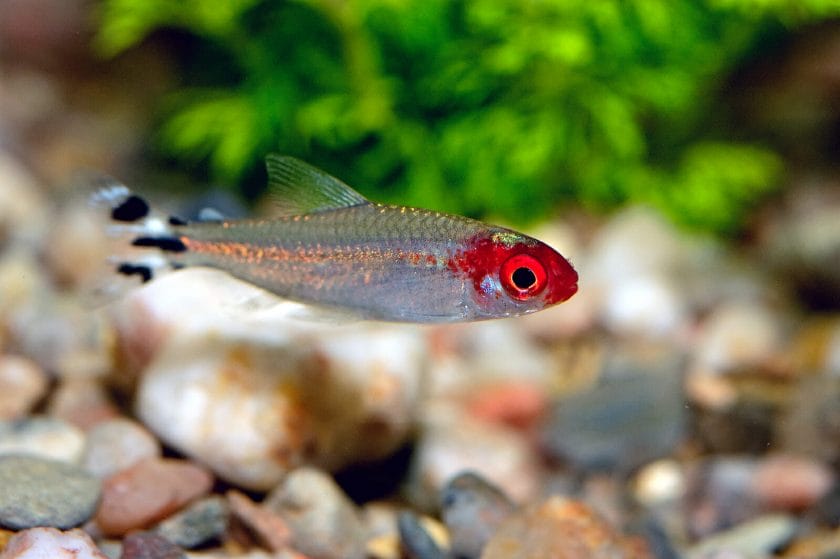
| PARAMETERS | VALUES |
|---|---|
| FISH | Rummy nose Tetra |
| SCIENTIFIC NAME | Hemigrammus bleheri |
| CARE LEVEL | Easy |
| MAXIMUM SIZE | 2 inches |
| AVERAGE LIFESPAN | 6-8 years |
| DIET | Omnivorous |
| WATER TEMPERATURE | 72°F - 80°F |
| WATER pH | 5.5 - 7.0 |
| BREEDING | egg layers |
28. Bristlenose Pleco
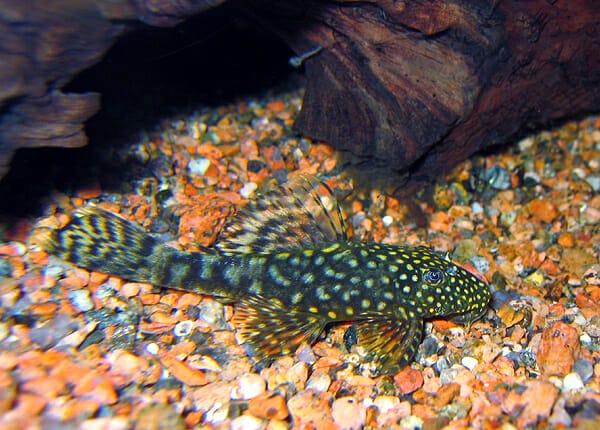
Image by Pia Helminen under CC BY-SA 3.0
| PARAMETERS | VALUES |
|---|---|
| FISH | Bristlenose Pleco |
| SCIENTIFIC NAME | Ancistrus Cirrhosus |
| CARE LEVEL | Easy |
| MAXIMUM SIZE | 5 inches |
| AVERAGE LIFESPAN | 5+ years |
| DIET | Herbivore |
| WATER TEMPERATURE | 73° - 81° F |
| WATER pH | 5.8 to 7.8 |
| WATER HARDNESS | 2° to 30° dH |
| BREEDING | Egg layer |
29. Female Betta
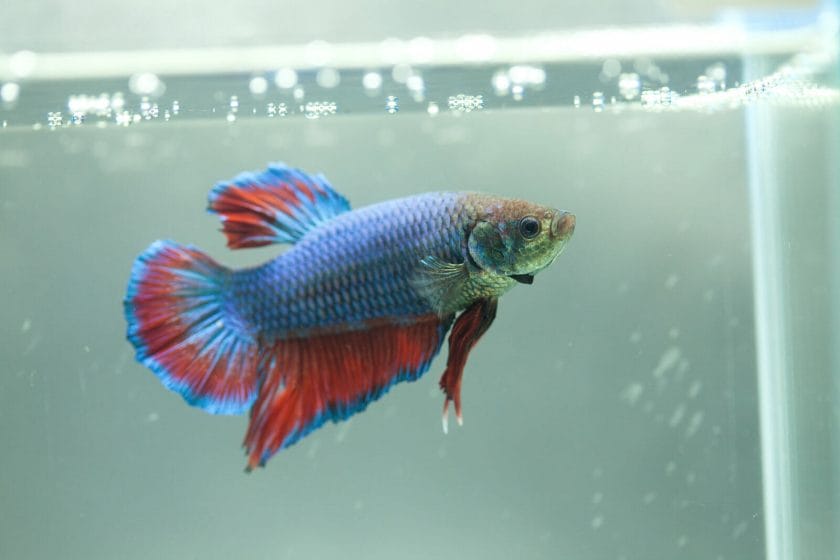
| PARAMETERS | VALUES |
|---|---|
| FISH | Betta Fish |
| SCIENTIFIC NAME | Betta splendens |
| CARE LEVEL | Easy |
| MAXIMUM SIZE | 2.25-3 inches |
| AVERAGE LIFESPAN | 3-5 years |
| DIET | Omnivores |
| WATER TEMPERATURE | 77° and 86° F |
| WATER pH | 6 - 7.5 |
| WATER HARDNESS | 5° to 20° dH |
| MINIMUM TANK CAPACITY | 2 gallons |
| BREEDING | Egg layer |
30. Amano shrimp
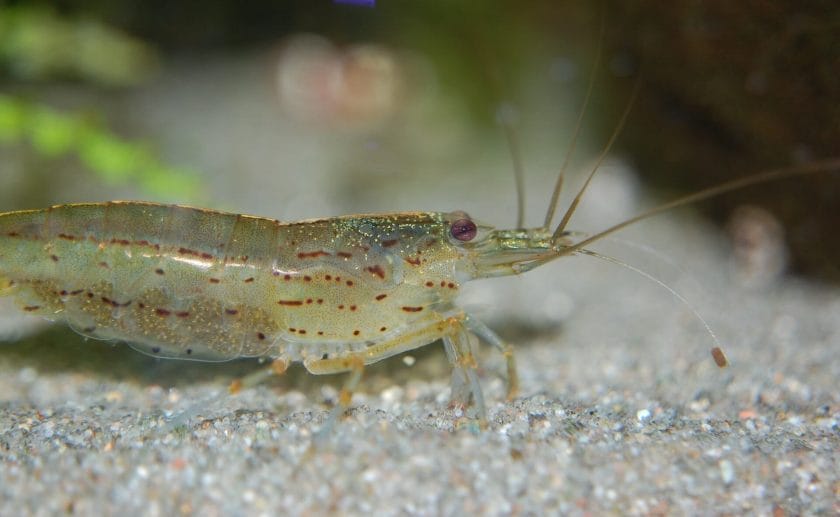
| FACTS | VALUES |
|---|---|
| FISH / INVERTEBRATE | Amano shrimp |
| SCIENTIFIC NAME | Caridina multidentata |
| CARE LEVEL | Easy |
| MAXIMUM SIZE | Up to 2 inches |
| AVERAGE LIFESPAN | 2-3 years |
| DIET | Omnivore |
| WATER TEMPERATURE | 70°F – 80°F |
| WATER pH | 6.0 – 7.0 |
| WATER HARDNESS | 6.0 – 8.0DKH |
| BREEDING | Egg layer |
| MINIMUM TANK CAPACITY | 10 gallons |
| TEMPERAMENT | Peaceful |
31. Crystal red shrimp
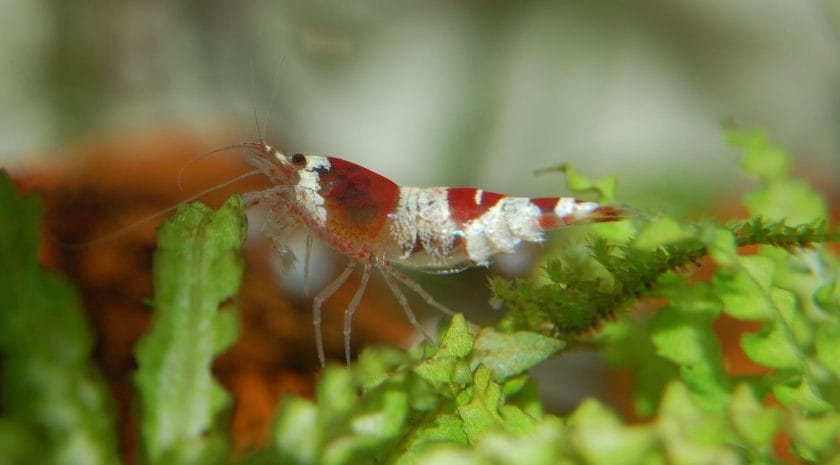
| FACTS | VALUES |
|---|---|
| FISH / INVERTEBRATE | Crystal red shrimp |
| SCIENTIFIC NAME | Caridina cf. cantonensis var. |
| CARE LEVEL | Intermediate |
| MAXIMUM SIZE | 1.2 inches |
| AVERAGE LIFESPAN | 1.5-2 years |
| DIET | Omnivore |
| WATER TEMPERATURE | 62-76 °F (16.5-24.5 °C) |
| WATER pH | 5.8-7.4 |
| WATER HARDNESS | 4-6 |
| BREEDING | Egg layer |
| MINIMUM TANK CAPACITY | 10 gallons |
| TEMPERAMENT | Peaceful |
What fish can live with guppies in a 5 gallon tank?
The best tank mates for guppies in a 5 gallon tank are as follows:
- Sparkling Gourami
- Honey Gouramis
- Chili Rasbora
- Dwarf Chain Loach
- Ghost shrimp
- Nerite Snails
- Crystal Red Shrimp
- Amano Shrimp
- celestial pearl danios
- Red Cherry Shrimp
You don’t have a lot of space in a 5-gallon tank. That’s why you should be extra careful while stocking a 5-gallon tank.
The fish I have mentioned above are small fish that can grow a maximum of 2 inches.
And they are not schooling fish so you don’t have to keep them in a group. You can keep only a single fish. That’s why they are very good tank mates for your guppies in a 5-gallon tank.
What fish can live with guppies in a 10 gallon tank?

Best tank mates for guppies in a 10 gallon tank are as follows:
- Dwarf neon rainbowfish
- White Cloud Mountain Minnow
- Espei rasbora
- Ember tetras
- Platy
- Cory Catfish
- Harlequin Rasbora
- Cardinal Tetra
- Otocinclus Catfish
- Kuhli Loach
- African Dwarf Frog
- Zebra Danio
- Ram Cichlids
- Rummy Nose Tetra
- Bristlenose Pleco
- Sparkling Gourami
- Honey Gouramis
- Chili Rasbora
- Dwarf Chain Loach
- Ghost shrimp
- Nerite Snails
- Crystal Red Shrimp
- Amano Shrimp
- celestial pearl danios
- Red Cherry Shrimp
In a 10 gallon tank, you can obviously keep all the tank mates that you can keep with guppies in a 5-gallon tank.
But in a 10-gallon tank, you can also keep other schooling fish because in a 10-gallon tank you have more space to keep a group of fish or to keep some large species of fish (up to 4 inches)
What fish can live with guppies in a 20 gallon tank?
Best tank mates for guppies in a 20 gallon tank are as follows:
- Siamese algae eater
- Boesemans rainbow fish
- Dwarf neon rainbowfish
- White Cloud Mountain Minnow
- Espei rasbora
- Ember tetras
- Platy
- Cory Catfish
- Harlequin Rasbora
- Cardinal Tetra
- Otocinclus Catfish
- Kuhli Loach
- African Dwarf Frog
- Zebra Danio
- Ram Cichlids
- Rummy Nose Tetra
- Bristlenose Pleco
- Sparkling Gourami
- Honey Gouramis
- Chili Rasbora
- Dwarf Chain Loach
- Ghost shrimp
- Nerite Snails
- Crystal Red Shrimp
- Amano Shrimp
- celestial pearl danios
- Red Cherry Shrimp
If you have a 20 gallon guppy tank then you have a lot of space to keep a lot of tank mates with your guppies.
In a 20 gallon tank, you can keep large fish like Boeseman’s rainbowfish, Siamese algae eater, etc.
From the above list, you can keep multiple species of fish in a 20 gallon tank.
What big fish can live with guppies?
You can keep big fish like Bristlenose pleco, Kuhli loach, Boesemans rainbowfish, Siamese algae eater with guppies.
You cannot keep very large fish like Oscar fish or African cichlids with your guppies because if you keep them with guppies then the guppies will most likely going to get eaten by them.
You can keep large peaceful fish up to a maximum of 4 to 5 inches with your guppies.
Which type of fish you should avoid keeping with guppies?
You should avoid keeping large fish like African cichlids and Oscar fish with your guppies.
Guppies can easily fit into the mouths of these fish. And if you keep them with guppies then your guppies will most likely be going to get eaten by them.
Besides, you should also avoid keeping aggressive fish with your guppies.
Guppies are peaceful fish and if you keep them with aggressive fish then they will get stressed and this can lead to diseases and even death of guppies.
You should avoid keeping other fish with guppies that do not require similar water conditions as guppies need.
This is important because if you want the fish to thrive in your guppy tank then you will need to make sure that you are maintaining the ideal water parameters that the fish need. And if it doesn’t get the ideal water parameters in the tank then it will not survive for long.
Do guppies need tank mates?
Guppies are schooling fish so you should keep them in groups in your aquarium.
Besides, guppies are peaceful, small freshwater fish and they do enjoy the company of other small, peaceful freshwater fish.
So you can keep other small, peaceful freshwater fish with guppies like Platies, Tetras, Rasboras, etc.
FAQ

Can guppies live with molly?
Both guppies and molly are small and peaceful freshwater fish so you can easily keep them both together in the same tank.
Just bear in mind, if you overcrowd your tank then this can make mollies aggressive.
And when they are aggressive guppies could be a perfect target for them because guppies have long fins and they can nip on their fins.
Can I mix guppies with tetras?
Both guppies are Tetras are small, peaceful, tropical freshwater fish so they are ideal tank mates for each other. And you can easily keep them in the same tank.
You can keep different types of Tetras with your guppies. For example.., Ember Tetra, Cardinal Tetra, Rummy nose Tetra.
Can you mix guppies and goldfish?
You can keep guppies and goldfish together in the same tank. Just make sure to keep them in at least a 20-gallon tank and make sure that you are not keeping too big goldfish or else your guppies will get eaten by them. And also make sure to maintain a constant temperature between 72° to 74° Fahrenheit.
What fish can go with guppies and neons?
You can keep small peaceful freshwater fish with your guppies and neons such as chili rasbora, espie rasbora, cardinal tetra, zebra danio, ember tetra, platies, harlequin rasbora, rummy nose tetra, etc.
What are the best guppy and shrimp tank mates?
You can keep small, peaceful fish with guppies and shrimp such as espie rasbora, platies, ember tetra, cardinal tetra, harlequin rasbora, etc.
You can also keep other invertebrates with guppy and shrimp such as Amano shrimp, Ghost shrimp, Nerite snails, etc
What fish can attack guppies?
Large aggressive fish like cichlids, blue acara, etc can attack guppies.
Fin nippers such as Barbs can also attack guppies.
Guppies can even get eaten by any large fish that has a large enough mouth where guppies can fit in easily such as a big goldfish.
How many guppies should be kept together?
You should keep at least a trio of guppies containing two females and one male in at least a 5 gallon tank.
You can keep more than 3 guppies, just make sure to increase the tank size accordingly.
When it comes to tank size for guppies, 1 gallon per inch of the fish is a good rule of thumb to follow.
Actually, I have written a detailed article on this very topic. You can check out the article here for more details.
Is it ok to keep only male guppies?
You can keep only male guppies in your fish tank. Just make sure to keep at least a group of 6 male guppies in the tank so the aggression will spread among them.
While keeping only male guppies in a tank you will see a lot of aggression.
If only one male guppy is targeted over and over then this can stress the fish which can lead to diseases and even death of the fish.
However, there are a few ways to cope and reduce the aggression in a male-only guppies tank.
I have written a separate article covering all the ways to reduce aggression in a male-only guppy tank you can check out the article here.
Conclusion
So thee were the best tank mates for your guppies.
I hope you found the tank mates mentioned in this article interesting and unique enough to keep them in your guppy fish tank.
Besides, if you like this article then please share it.
Happy fishkeeping!

